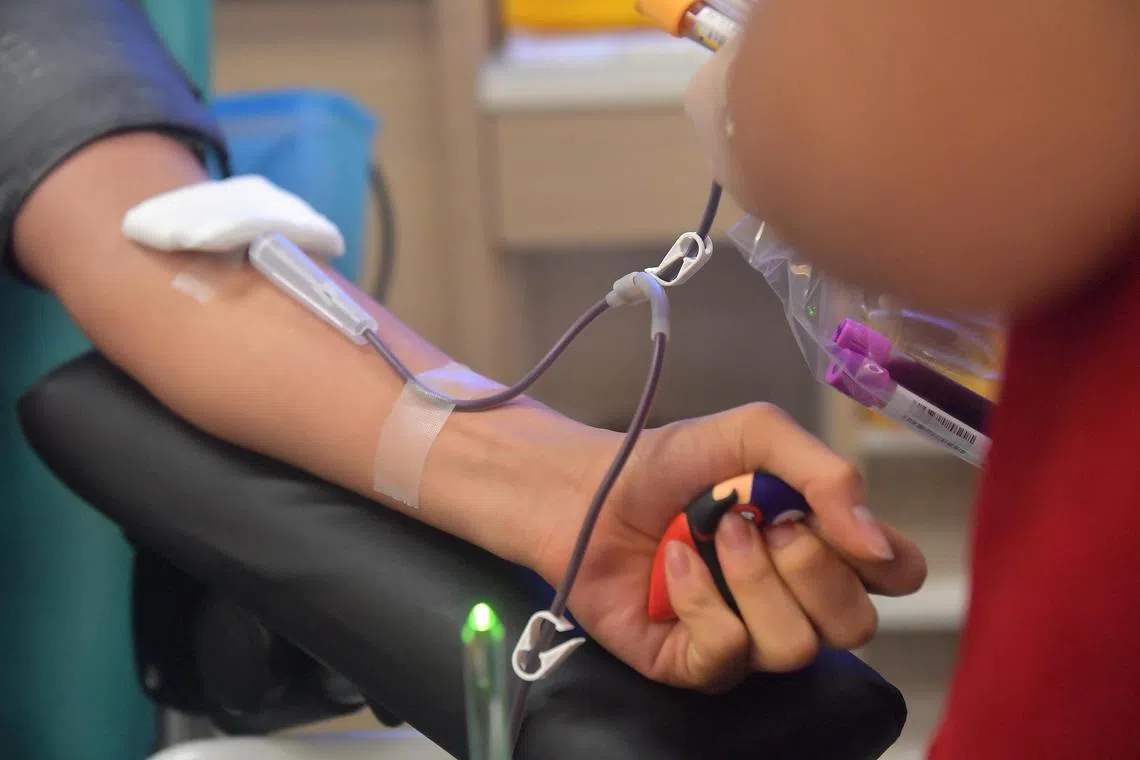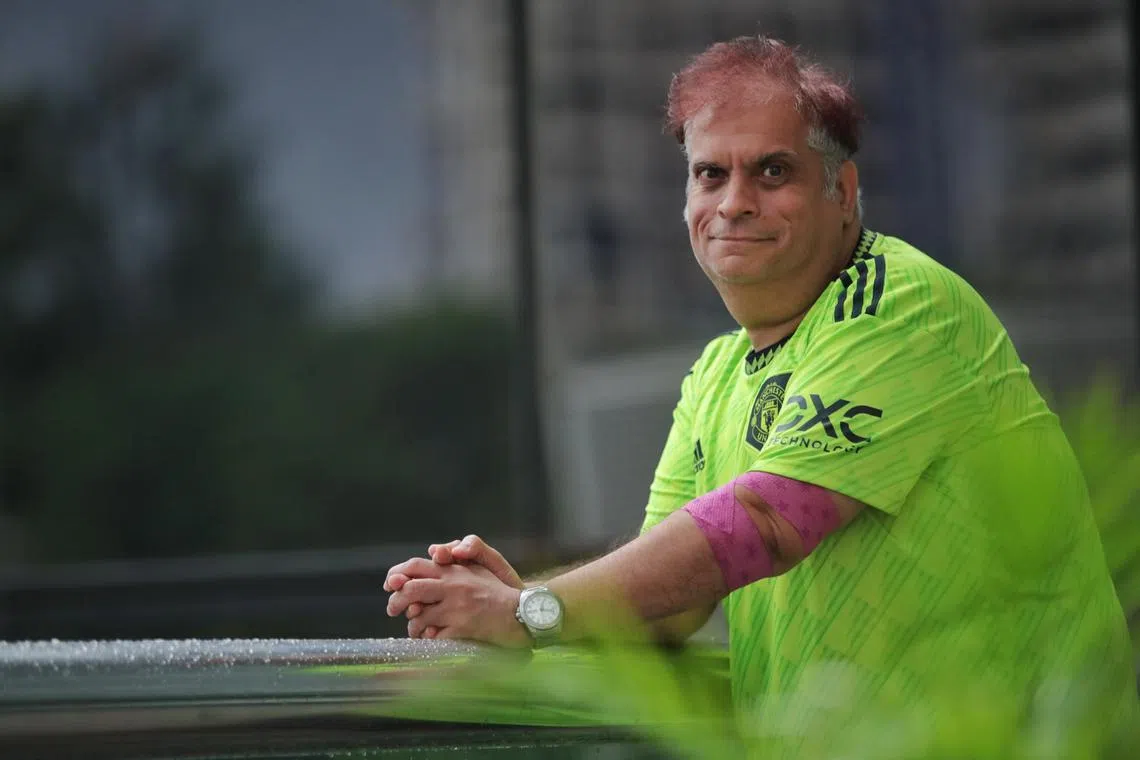10% dip in young blood donors in 2022, cancelled mobile blood drives a factor
Sign up now: Get ST's newsletters delivered to your inbox

Young blood donors aged 16 to 25 made up 17 per cent of Singapore's donor pool in 2022.
PHOTO: ST FILE
Follow topic:
SINGAPORE - The number of young blood donors aged 16 to 25 fell by 10 per cent in 2022, even as the overall number of donors went up.
This is a concern for the Singapore Red Cross (SRC), who said getting more donors to start young is crucial for ensuring the sustainability of blood supply for both emergencies and patients who require regular transfusion.
SRC said the number of young donors fell 10.3 per cent from 13,967 in 2021 to 12,527 in 2022. They made up 17 per cent of the donor pool in 2022.
In 2021, youth constituted 20 per cent of all donors. More than a decade ago in 2011, they accounted for 33 per cent.
SRC said the Covid-19 pandemic was a factor in the decline of young blood donor numbers in 2022.
“During the pandemic, many of our mobile blood drives were cancelled. These included tertiary and community blood drives, which are important avenues for youth donors to start their donation journey,” said its spokesman.
Other concerns such as fear of needles and pain, as well as the misconception that donating blood is inconvenient, were also reasons for the decrease, said SRC.
To help young people understand the importance of donating blood, SRC said it advocates the inclusion of blood donation in the mainstream school curriculum.
“We run blood donation talks, organise learning journeys to the Bloodbanks, and conduct exhibitions and roadshows in schools regularly. We also run outreach skits in secondary schools to get them interested in this life-saving cause,” added the spokesman.
Despite the drop in number of youth donors from 2021 to 2022, there was a 7 per cent increase in the total number of donors from 69,032 to 74,154.
SRC also observed that among individuals who had not donated blood for two years, more stepped forward to do so in 2022.
This group formed 21 per cent of the donor pool in 2022, up from 15 per cent in 2021.
The spokesman said: “This could be due to improvement of the Covid-19 situation, which made them more comfortable to resume blood donation. We had also put in more emphasis on recalling this group of donors in our SMS and tele-recruitment effort, which could have contributed to the overall increase.”
But even with the increase in blood donors, SRC noted that about 600 people stop donating blood each year due to age or illnesses.
Blood stocks can also dip as much as 20 per cent across all blood types during long weekends and school holidays when donors tend to travel overseas.
“Travelling to certain countries or regions in some countries with insect-borne infection risks may make donors ineligible to donate blood for a period of time,” said the spokesman.
Depending on which country they visited, donors may have to wait between 28 days and four months upon return before donating blood.
For instance, those who visit a malaria endemic area for more than a day would have to wait for at least four months before they can donate blood. Such areas include Batam, Bintan, Cambodia and India.
Individuals who travel to places with transmission risk of the West Nile Virus, such as Canada, Greece and the United States, would have to wait for 28 days.
SRC emphasised that it is crucial to constantly increase the pool of donors. “We need more youth donors to start donating now and make it a lifelong habit. This will ensure the sustainability of our blood supply into the future,” the spokesman added.
SRC said a common misconception is that the blood collected is used only for emergency procedures. In fact, around 34,000 patients each year need a steady supply of blood to sustain or improve their quality of life.
“Blood is not merely required for those with bleeding from injuries or surgery. It is also needed to meet the critical needs of patients with blood disorders or other medical conditions,” the spokesman said.
Ms Wong Anwen was only 13 when she was diagnosed with leukaemia or cancer of the blood.
Recalling the events that led to her diagnosis and treatment six years ago, Ms Wong said: “It started off with a fever that would not go away. So I went to the doctor and after many tests, he told me I had leukaemia, and that I needed blood transfusion before the cancer could be treated as my red blood cell count was pretty low.”
She added: “My parents were concerned about the availability of blood at first, but thankfully I managed to get the blood I needed to begin chemotherapy.”
After the blood transfusion, Ms Wong began her two-year treatment. Her cancer is now in remission.
“I am very grateful to the person who donated blood to me. I feel like, in a way, this person saved my life,” said Ms Wong, now 19 years old.

Ms Wong Anwen with her mother at KK Women’s and Children’s Hospital in 2017.
PHOTO: COURTESY OF WONG ANWEN
Said the SRC spokesman: “With an ageing population and more sophisticated medical procedures, the demand for blood is ever increasing. Therefore, we need to continually grow the pool of blood donors – especially youth donors, and encourage current donors to donate blood more regularly.”
For Mr Tulsiani Rajesh Lilaram, donating blood has become second nature.
The 51-year-old, who works as a community care associate in the healthcare sector, has donated blood 148 times.

Mr Tulsiani Rajesh Lilaram started donating blood around 30 years ago and has done so 148 times.
ST PHOTO: GIN TAY
He said: “It started around 30 years ago, when I came across a blood donation drive and felt compelled to donate.
“Since then, I’ve tried to donate blood regularly. After all, it takes only around an hour of my time. I believe it can make a big difference to someone, even though I may not know them.”


